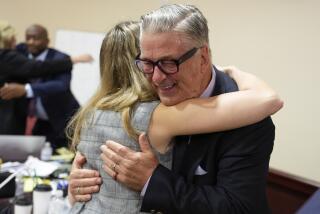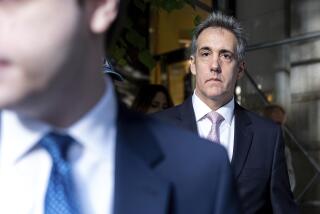Defense Steps Up Attack on DNA Tests
- Share via
With an increasingly restless jury demanding longer court weeks, one of O.J. Simpson’s lawyers spent a frustrating morning Friday trying to elicit testimony from a prosecution witness that would bolster the defense’s claims of evidence contamination or tampering.
Hampered by repeated prosecution objections that Superior Court Judge Lance A. Ito generally sustained, defense attorney Barry Scheck used his second day of cross-examining a California Department of Justice analyst to try to chip away at the heart of the government’s case against Simpson--the DNA evidence.
Scheck succeeded in some regards, contrasting Gary Sims’ careful, methodical work habits with what the defense alleges were the sloppy practices of the Los Angeles Police Department, and eliciting the witness’s admission that he does not know how or where one of Simpson’s socks was stained with blood.
At times, however, the defense attorney’s examination was based on hard-to-follow mathematical computations, and at other times it seemed to veer toward the absurd, as when Scheck tried to persuade the witness to criticize an FBI study of contamination of DNA tests.
Although Sims was the only witness to testify Friday, the day also was marked by two other significant developments: Court officials revealed that jurors have asked for a six-day court week to speed up the trial, and prosecutors unveiled their most detailed description to date of how they allege the June 12 murders were committed.
Simpson has pleaded not guilty to killing Nicole Brown Simpson and Ronald Lyle Goldman, both of whom were knifed to death outside Nicole Simpson’s Brentwood condominium.
During the morning session, Scheck challenged an array of particulars about the handling of evidence in the Simpson case, attacking not only the evidence itself but even such obscure elements as the scientific literature debunking the susceptibility of blood to contamination.
Noting that the FBI analysts tried to cough on samples in an effort to test their vulnerability to contamination, Scheck asked Sims whether the analysts should have sneezed instead because it would have been a better test.
The FBI test concluded that coughing on samples did not produce a false DNA test result. But sneezing, Scheck suggested, produces more of the fluids that contain DNA and thus would better have challenged the evidence.
Sims, however, seemed baffled by the questioning. Several times, he asked Scheck to repeat long, hypothetical questions, and the witness occasionally challenged Scheck’s scientific assumptions.
“There’s tremendous variation, just as from cough to cough, from spit to spit,” Sims said at one point.
Prosecutors have built their case against Simpson largely around DNA analysis performed on scores of bloodstains discovered at the scene of the crimes, inside Simpson’s car and at his Brentwood estate. In a series of riveting disclosures during the past two weeks, prosecution witnesses revealed the results of those DNA tests, which suggest that blood with Simpson’s genetic characteristics was found at the crime scene and that blood with markers matching that of the two victims was found at his home and in his car.
On Friday, Deputy Dist. Atty. Rockne Harmon suggested that Simpson’s defense team might have tampered with at least one piece of that evidence, a bloodstain found on the back gate of Nicole Simpson’s condominium. Harmon did not explain the basis for that accusation, and conceded that he cannot be sure the defense collected the bloodstain, only that photographs suggest that part of it is missing.
“I don’t know if they took it,” Harmon said. “Now is the time to start fessing up if they did.”
Ito asked Scheck whether the defense had taken blood from the scene of the crimes, which, if true, would be illegal. Scheck looked to his colleagues inquiringly. Lead trial lawyer Johnnie L. Cochran Jr. shook his head, and the other lawyers appeared puzzled.
“No, not to my knowledge,” responded Scheck, whose distaste for Harmon is no secret. “I have no idea what this man is talking about.”
Speeding It Up
Friday’s cross-examination came as frustrated jurors once again tried to take an element of the trial into their own hands.
Having successfully forced the ouster of three Sheriff’s Department deputies from the jury detail and two talking journalists from the courtroom, the jury now has asked that court hours and days be extended.
In a note to Ito, apparently delivered earlier this week but publicly revealed Friday, an unknown number of jurors requested that the half-day typically scheduled for Fridays be extended to a full day and that a Saturday session be added as well.
Jerrianne Hayslett, a court spokeswoman, said Ito is considering the request, which would force the court to pay overtime costs to staff the trial on weekends, when the criminal courts normally are closed. On the other hand, the jury is sequestered, so any shortening of the trial would also save hotel and meal costs associated with the sequestration.
On Friday, Ito did not publicly respond to the jury’s request for longer court hours, but he sent the panel home for the day with an assurance that he and the lawyers would be hard at work.
“Just for your information,” Ito said, “we will be working on this case and other cases this afternoon. So we’re just taking a lunch break. All right? You all have a nice weekend.”
Questions on Evidence
As Scheck conducted his cross-examination Friday, he continued the tack he has taken with Sims, declining to rope the analyst into the defense conspiracy theory but using his testimony in an attempt to undermine other prosecution witnesses.
Under questioning from the defense lawyer, for instance, Sims acknowledged that the LAPD had not initially sent him samples used to test for possible contamination. Only after Sims requested those samples were they sent to the Department of Justice, he said.
Turning to the bloody glove that police say they discovered at Simpson’s estate, Scheck pointed out that police had examined the item before it was sent to Sims’ lab, suggesting that tampering could have taken place while it was at the LAPD. The initials of a police analyst, Colin Yamauchi, are on the glove, and though the jury has not heard about it, the LAPD did subject portions of the glove to DNA testing at the Police Department laboratory.
The defense repeatedly has suggested that evidence was mishandled while in police custody, and on Friday Scheck questioned Sims at length about the condition of a pair of socks when they arrived at the Department of Justice lab.
Defense lawyers contend that blood was planted on those socks, an allegation that prosecutors have rebutted in part by stating that the splatter pattern of blood on the socks does not support a planting theory. In addition, Sims testified that blood on the socks did not soak through from one side to the other, suggesting that they were being worn when the blood came into contact with them.
On Friday, as the court week wound to a conclusion, Scheck brought the jury’s attention back to the socks and to the testing performed on them by the Department of Justice and Cellmark Diagnostics, a Maryland-based private lab also used by authorities in this case.
“Mr. Sims,” Scheck asked, “you are not part of any conspiracy to tamper with evidence in this case, are you?”
“No,” the normally relaxed witness said with a hint of anger. “No, I’m not.”
“To your knowledge, Dr. Cotton from Cellmark is not part of any conspiracy to tamper with evidence in this case?” Scheck then asked, prompting a prosecution objection.
Ito overruled it, and Sims responded: “No, I don’t believe she is.”
After one other question was successfully blocked by prosecutors, Scheck then asked: “Do you know from your own personal knowledge how and when that blood got on the sock?”
“No,” Sims said.
Dispute Over Photos
Once the jury was gone for the day, and Ito had spent an hour or so checking up on another case with which he is involved, the judge met with attorneys for both sides to discuss the prosecution’s desire to show the jury 40 to 50 autopsy photographs. Simpson’s lawyers object to that plan, which they contend is designed to inflame the jury’s passions and improperly induce the panel into convicting Simpson.
Robert L. Shapiro, the attorney who built Simpson’s legal team, said the photographs do not shed light on any important issue in the case, since the defense agrees that the murders were horrific and brutal.
Although Friday’s debate on that issue did not produce a resolution on the photograph dispute, during the course of the argument, Deputy Dist. Atty. Brian Kelberg offered the prosecution’s most descriptive explanation for how the murders were committed and told Ito that the government lawyers concede that medical examiner Irwin Golden made many mistakes in performing the autopsies in the Simpson case.
Kelberg also said, however, that none of Golden’s mistakes affected the overall case.
Speaking to a nearly empty courtroom without even Simpson present, Kelberg said that the wounds to Goldman did not show evidence of twisting that would have indicated resistance from that victim. The absence of such evidence suggests that many of those wounds were inflicted with malice after Goldman ceased to put up resistance, Kelberg said.
The prosecutor was even more detailed in his description of how authorities believe Nicole Simpson was killed. Autopsy reports reveal that she had several stab wounds to her neck and a bruise to her head, the combination of which could have rendered her helpless, Kelberg said.
And the deep wound to her throat, he added, suggested that “the perpetrator who we contend is the defendant O.J. Simpson [came] up from behind her, placing a foot on the part of her back that has this non-specific blunt force trauma under her dress area and then pulling with one hand her hair and pulling her head back, which would obviously then expose the full area of the neck.”
Then, Kelberg said, the murderer took the knife in his right hand and drew “it across from the left to the right in the upward angle,” slashing the victim so deeply that it bolstered the prosecution’s contention that the murder was both premeditated and motivated by intense rage.
More to Read
Sign up for Essential California
The most important California stories and recommendations in your inbox every morning.
You may occasionally receive promotional content from the Los Angeles Times.











